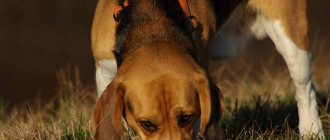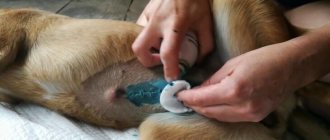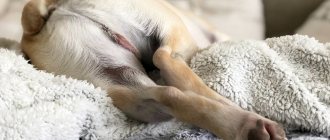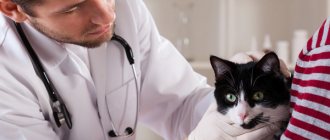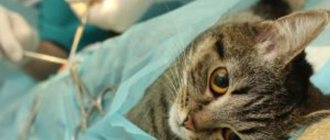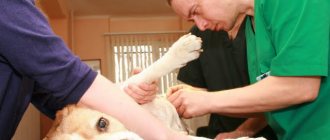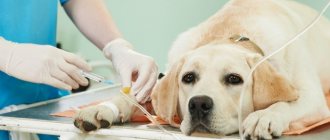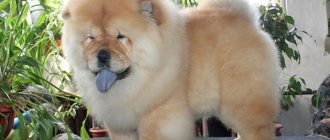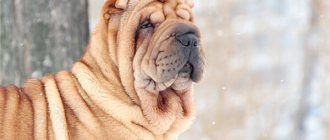Recommendations for owners in the postoperative period
A special place is occupied by maintaining rest for the animal. It is necessary to take care of a comfortable, favorable, warm, but not stuffy place:
To recover, the animal must experience minimal stress and rest more. During the operation, the pet experienced stress, so it may be aggressive.
- On the first day after surgery, the dog cannot eat or walk for a long time.
- It is mandatory to wear a blanket for dogs after surgery so that it does not touch the stitches.
- Sutures in a dog after surgery require special care, so treatment of the suture after surgery in a dog must be carried out with a local antiseptic solution once a day. After the wound has been treated, antiseptic ointment is applied.
- All medications are given strictly as prescribed by the doctor so that the dog feels comfortable.
- Pain medication for dogs after surgery is given exactly according to the schedule, since a disrupted medication schedule can have a negative effect on the recovery process.
Medicinal postoperative support
How can you relieve pain (usually it takes a day - maximum two and strictly as prescribed by the doctor, because there may be a conflict with the remains of anesthesia in the body):
- Meloxicam - intramuscularly at a dose of 0.2 mg/kg on the first day, then 0.1 mg/kg for another 1-2 days.
- Tolfedine – 4 mg/kg orally with food or water once a day (how much in tablets will depend on the dosage component).
- Rimadyl (carprofen) - administered subcutaneously at the rate of 1 ml of the drug for every 12.5 kg. Once a day. No longer than 3 days.
- Ketanov – 1 ml/13 kg maximum up to 2 times a day.
- Ketofen (ketoprofen) – 0.2 ml/kg once a day for no longer than 4 days.
- Travmatin - calculation 0.1-0.2 ml/kg, but not more than 4 ml per injection.
Treatment of seams (according to the instructions for the preparations):
- Vetericin spray;
- Chemi spray;
- Aluminumspray;
- Horhexidine;
- Betadine + sea buckthorn oil or rosehip oil;
- Levomekol ointment;
- Terramycin spray.
General strengthening agents:
- Vitam - from 1 to 4 ml subcutaneously, depending on the size of the dog, twice a week until the sutures heal.
- Gamavit - if for general preventive therapy, then 0.1 ml/kg is enough, if the dog is weakened, then 0.5 ml/kg. The general course is prescribed by the veterinarian, because can be administered daily or at intervals of several days, depending on the condition of the dog.
If the stitch is bleeding:
- Vikasol – 1 ml/5 kg intramuscularly twice a day at regular intervals. Can be used separately or together with etamsylate.
- Etamsylate - 0.1 ml per kg of body weight twice a day.
Postoperative nutrition for the animal
specific recommendations about what the dog can do after surgery . This directly depends on the type of surgery and anesthesia.
The dog breeder wonders what to feed the dog after surgery ? We offer the following:
- Feeding should be done little by little so as not to burden the body, since a lot of energy is spent on digesting food.
- After surgery, the dog does not eat or drink for several hours. This is especially true for operations performed on the peritoneum.
There is no need to worry that the dog does not go to the toilet after surgery . This is natural, because she doesn’t eat anything. And to avoid constipation, you need to stick to a diet. It is better to give dietary food, which is sold in special canned food. Hard food softens in warm water. This type of diet is observed for about 30 days. It is better to return to your normal eating rhythm gradually. To do this, the usual food is gradually mixed into the diet.
In the postoperative period, it is preferable to give the dog broth, cottage cheese, kefir and porridge.
There must be fresh drinking water near the dog.
The owner must inform the treating veterinarian about negative reactions to food in the form of vomiting, diarrhea, constipation.
Types of post-traumatic stress for dog recovery.
The first thing to remember is that the dog’s complete return to normal life and good condition will occur +- after 3 months
such restoration. You need to have patience and do everything very slowly and gradually. In addition, as I wrote above, if there is any deterioration, stop doing what you were doing.
And I think it doesn’t require a reminder that:
During the first 2 months of this recovery, any walks without a leash, playing with other dogs, jumping, and running loose are still prohibited.
Walking leisurely walks with the dog.
Also, I want to clarify, since I always hear this question from patients: we do not pay attention to exactly how the dog walks, if it is a walk or a trot. We estimate the pace of movement by your step. Naturally, if I say you walk at your slow pace, then you will need to match the tempo of your step to your breed. If you, having a Great Dane or a Wolfhound, can barely crawl, then the dog simply will not be able to walk at all, in this case, of course, you will have to walk not at a very slow pace, but in such a way that the dog can move smoothly, but very slowly, at a pace next to you. If you have a Spitz, then you will need to walk very, very slowly, let’s say practically crawl, so that the dog walks at a slow pace.
Swimming for dogs.
Swimming in a pool or in a pond (if it’s summer) is allowed in any quantity (but if it’s a pond and if it’s cool, the dog needs to be thoroughly dried and taken home), and when I say swimming, I mean swimming, not splashing around in the water or diving.
Is running necessary?
Treadmills... better hold off. Because treadmills, as I described in one of the articles, have 2 sides of the coin.
Also, please remember that for a dog such a load, which is described below, is very large (yes, I know, there is an opinion that the best and sufficient load for a dog is walking without a leash, but this is a myth, a dangerous myth!), so don’t worry, if your dog, after what you think are small walks, sleeps like the dead or seems very tired. This is fine!
What is the feature of the protective structure?
A collar for a dog after surgery serves as a kind of limiter or barrier in protective therapy. The technique helps protect the dog from causing various types of damage to itself and prevents it from biting or scratching itself. This increases the likelihood of the wound healing quickly. These devices are prescribed by veterinarians in case of surgery, as well as in other incidents.
Pets do not like to visit clinics, so restraints in the form of collars make it possible to visit doctors less often. The wound heals faster, the risk of infection is reduced, and the dog does not come into contact with drugs used to treat the skin.
The device has the shape of a cone, which is cut off at the top. The material can be anything that holds its shape. The positive thing is that an animal with such a device eats food calmly. Try to get the dog used to this thing, and then it will stop worrying and accept it better.
Symptoms of high fever in dogs
In order to find out the temperature of an animal, it is enough to measure it with a thermometer. But the device may not always be at hand, then you need to pay attention to external signs.
Symptoms of hyperthermia
- dry nose;
- hot ears;
- teeth grinding;
- slight trembling throughout the body;
- tachycardia;
- rapid breathing;
- unnatural behavior: the dog hides behind the sofa or, on the contrary, is afraid to move away from the owner;
- refusal to eat;
- convulsions;
- redness of the skin;
- general lethargy.
However, these symptoms should not be considered clear signs of hyperthermia in an animal. For example, dogs often develop a dry nose after sleep, and teeth grinding may be a reaction to severe stress.
At high temperatures, one or more of the above symptoms may occur. If your dog starts having convulsions, you need to go to the doctor immediately; he needs emergency help.
How to take a dog's temperature
Temperature in dogs is measured rectally using a thermometer. It is better to use an electronic thermometer, but you can also use a mercury one.
- Treat the thermometer with a disinfectant.
- Lubricate the tip of the thermometer with Vaseline or a thick, fragrance-free cream.
- Secure the animal so that it cannot sit down.
- Insert the thermometer into the dog's anus to a depth of 1.5 cm and hold for several minutes.
After measuring, calm your pet down and give him a treat. The thermometer is then disinfected and put back in place.
What temperature is critical for a dog?
A dog's body copes much better with low temperatures than with high temperatures. In extreme heat, irreversible changes occur in the brain and other organs of the animal. Temperatures above or around 42 degrees Celsius are considered critical.
If you do not immediately take the animal to a doctor, complications are possible.
- respiratory paralysis;
- acute honorary failure;
- intoxication of the body;
- heart failure;
- cerebral edema;
- hypoglycemia;
- hyperbilirubinemia;
- coma;
- death.
Self-medication at high temperatures is unacceptable and can threaten the life of the animal.
What complications can occur after surgery?
- A dog after surgery needs quality care because it is more susceptible to complications that may arise against this background. Among other things, you cannot always force the dog to rest in order to allow the wound to heal normally. This is due to the fact that you cannot explain to her how to behave after the operation, namely:
- If the dog is not stopped in time, it can damage the wound and this will lead to the resorption of the sutures.
- Allergies can also occur in dogs. The owner does not always know the reaction of the dog’s body to one or another type of drug.
- Swelling after surgery in a dog may occur due to excess fluid that has accumulated near the wound. Swelling will cause the stitches to come apart and the wound will be vulnerable to infection.
- Bloody discharge from a wound in the first days after surgery should be a cause for concern.
- If the sutures dissolve early or are placed incorrectly, a hernia may form.
Dog after anesthesia
After the operation, the dog needs maximum rest as it recovers from anesthesia. Quite often in this regard you can hear the question: how long does it take for a dog to recover from anesthesia? Under such circumstances, the purely individual characteristics of the body come into play. There are dogs that manage to recover from the state of anesthesia in a few hours, while others need the whole day. When recovering from anesthesia, the dog may experience complications:
- Waking up after surgery is delayed.
- The animal may vomit.
- The dog is trembling after anesthesia.
- Your pet's breathing becomes slower.
- Your pet's heart rate may weaken.
- The dog begins to breathe rapidly and wheeze. Such a danger may arise if the animal has problems with the cardiovascular or respiratory system, or there is some kind of pathology.
- Possibly a drop in temperature.
- Allergic irritation on the stomach is possible.
- The dog is shaking after anesthesia.
- There may be problems with the toilet (constipation, urine does not flow on its own).
The owner should know that the dog needs to wet his lips and tongue with water in cases where the pet is not able to quickly recover from anesthesia. It is necessary to place water next to the place where the operated animal lies. You can start giving your dog water five to seven hours after it comes out of the anesthesia state. But with feeding, you should wait. Food can only be offered to her after ten to twelve hours.
At a later stage, postoperative stroke or pulmonary edema may occur. This development can occur in weakened animals or animals that have prerequisites for these diseases. High-quality and timely diagnosis by a doctor can reduce unwanted consequences for your pet to a minimum. For advice, contact your veterinarian. At the same time, carefully weigh the pros and cons before you agree to administer anesthesia to dogs, unless this is an urgent life necessity.
Anesthesia is used quite often in veterinary practice and not only during operations. Being in a state of excitement, the dog may behave aggressively with the doctor or owner and refuse to follow his commands. To eliminate this behavior during various medical procedures, general anesthesia is used.
General rules for caring for your dog after surgery
The main rule is to strictly follow all the recommendations of the specialist who performed the operation on the pet. Do not make your own adjustments to the advice given. Otherwise, it will end badly for the dog itself. If the doctor’s words make you doubt the benefits for your pet, then do not look for a solution to the problem on the Internet. Consult another veterinarian. Based on the tests and the general condition of the dog, he will prescribe suitable medications and give an expert assessment of the current situation. But there are also general rules of care that will help your pet recover after surgery.
Rehabilitation period
It is a mistake to believe that the dog will become as active a day after surgery as it was before surgery. As a rule, the rehabilitation period takes about two weeks. The more complex the operation and the more serious the intervention, the longer the pet will have to recover. Much depends on his age. Older animals, like older people, take significantly longer to fully recover.
The first day after surgery: recovery from anesthesia
Anesthesia is a significant burden on the animal's body. Therefore, no one can predict in advance how your pet will endure it.
Don't rush to take your dog home quickly. Wait until the animal finally comes to its senses.
Next, caring for the dog falls on your shoulders.
On the first postoperative day:
- Provide your pet with absolute rest.
- Avoid walking.
- Don't feed the animal.
- Cover the dog with a blanket (this will warm him up and also protect the sore spot from hypothermia).
